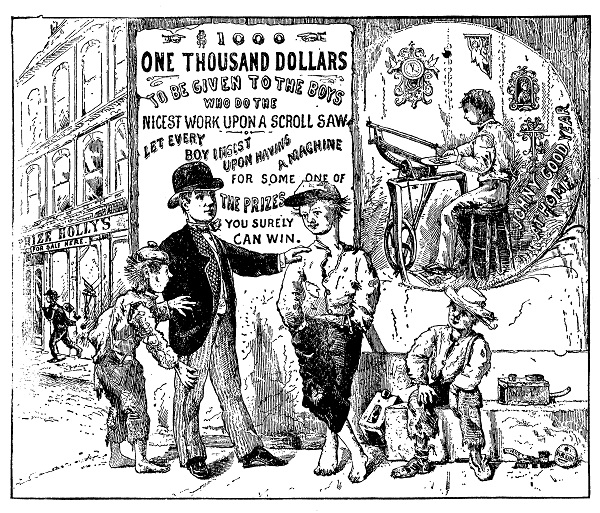So what was the significance of these relatively short lived (about 1870 to about 1930) machines? There were several that had we lived in that time we would have been better able to observe and appreciate.
Productivity Improvements
Vast improvements in productivity were seen especially for contractors, builders, pattern makers and small shops that could not afford the cost of a steam or gas engine and the associated line shaft set-up to distribute the power. Sawing showed perhaps the greatest leaps in productivity. After all, you were going from a hand operated fret saw or regular handsaw to a real machine. This is reflected in the following testimonials from some of the early Barnes catalogs.
“Sawed out $40 worth of scroll work at factory price at a cost of $10 (lumber & labor) making a profit equal to the cost of the machine.”
“Sawed out a large panel bracket (gingerbread for a Victorian house) in 12 minutes that the factory man wanted $1 for. That would be over $40 per day profit.” (As an aside, I have cut out a bracket from a 2” by 12” piece of southern yellow pine in about that same time on a Barnes #2 scroll saw so it can be done today.)
Even kids could make a half dozen picture frames in 2 hours for a profit of $1.30 on one of the hobby grade saws.
Metal lathes now offered the gunsmith or blacksmith the ability to make parts from all types of metal by turning & milling and to be able to cut virtually any type tread in a very accurate manner.
This productivity improvement was very significant when the average wage for a skilled wood worker in 1875 was $30 to $40 per month working 60 hours per week.
Small Shop & Home Workshops
With the commercial availability of foot powered machinery, small shops as opposed to massive factories were now realities. These could be located in small towns or rural areas where they could only get “manufactured” products by ordering them from a factory or distributor. (In today’s world, we take for granted on-line ordering and next day arrivals while back then it could takes weeks to get an order in via the mail and the item shipped back via rail.)
These machines also provided the ability for home workshops whether you used the hobby or amateur grade machines of the more robust commercial grade machines. Just think what it must have meant to be able to make something using machinery in your own workshop like we do today.
Social Implications
This is an area that might not be as obvious as the two described above. These machines were marketed to women as well as children. It was fashionable back then for women to be able to show they could cut out scroll work and do turnings on lathes.
A. H. Shipman was very successful as a company targeting this area. They said it would give a way to test to see if children were mechanically inclined and even pitched that by having a scroll saw, it would keep fathers at home offering many pleasurable hours with the family.
Many of these amateur grade machines were given away as prizes for sales contest targeted at children and youth.

